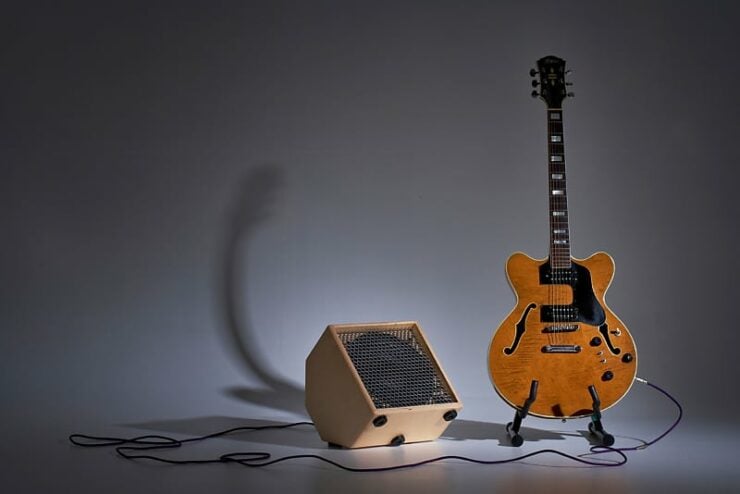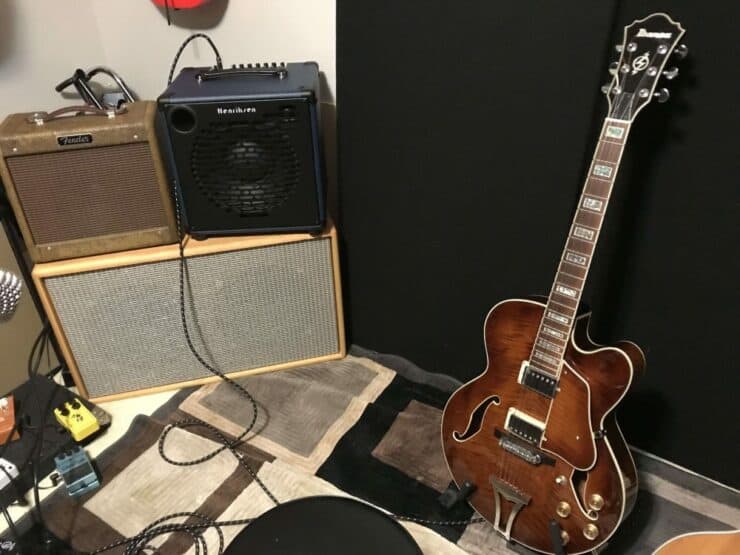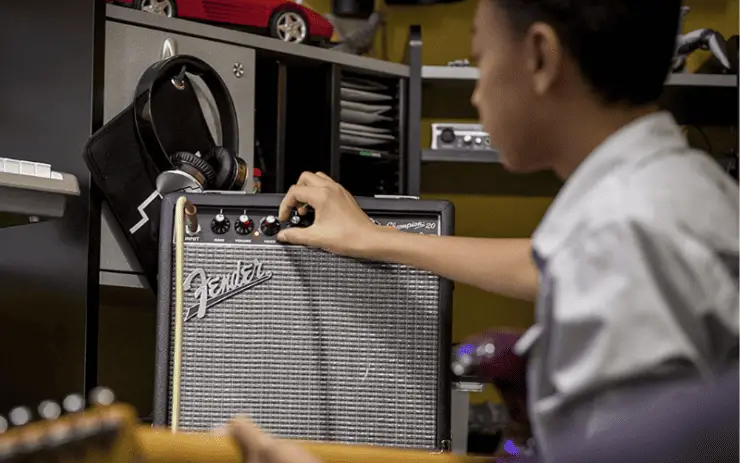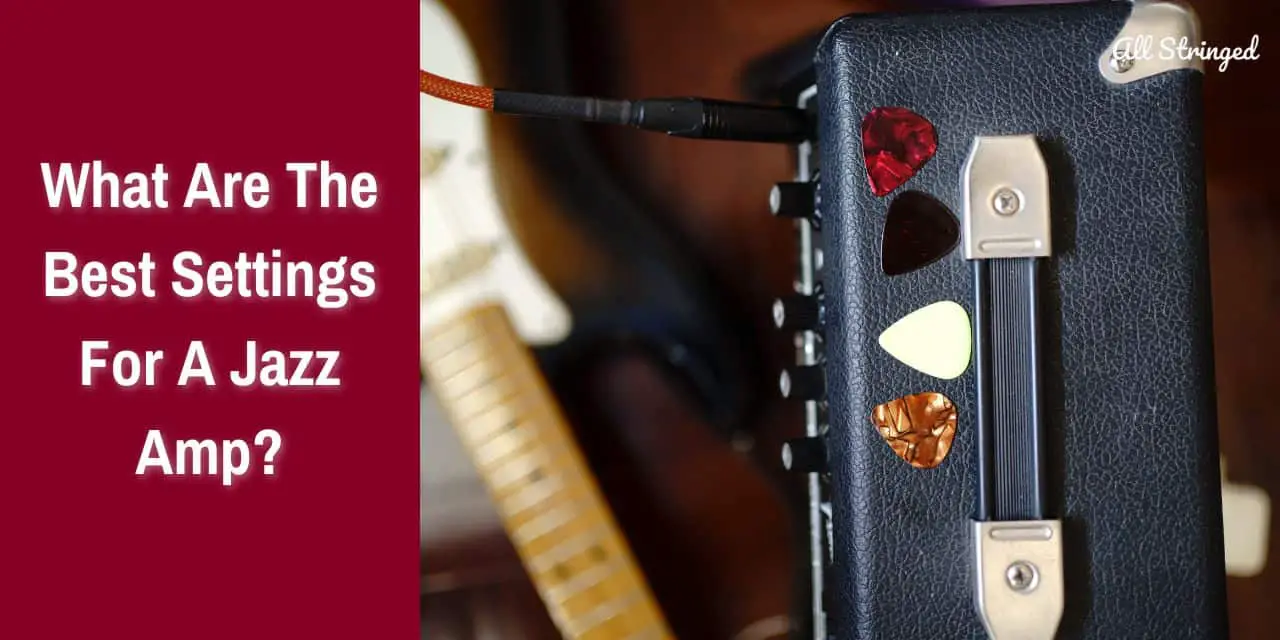Are you a jazz guitar player? Are you looking for the best settings to get that perfect sound? Look no further! In this article, we will discuss the best settings for a jazz amp so you can get the most out of your sound. Whether you are just starting out, or an experienced player, this article is for you. Read on to discover the perfect settings for your jazz amp!
What is a jazz amp?
Jazz is a genre that is renowned for its improvisational prowess, expressive melodies, and intricate harmonies. This genre demands an amp that can capture and enhance its unique characteristics. The jazz guitar amp is an important tool in a guitarist’s arsenal as it plays a key role in shaping the artist’s tone and delivering the nuances that define the genre’s rich sound.
In simple words, a jazz amp is an amplifier that is tailored to meet the specific requirements of jazz guitarists. Unlike amps designed for other genres like metal or rock (which often emphasize distortion and high gain, a jazz amp prioritizes warmth, clarity, and tonal balance. Its purpose is to offer a pristine platform for the guitarist’s intricate fingerpicking, complex chord voicings, and sophisticated improvisations to shine through.
>>> Click here to read our review about the Top 15 Best Jazz Amps <<<
Here are some of the key characteristics of a jazz amp –
#1. Clean and transparent tones
Central to the jazz genre is the desire to present chords, melodies, and solos with pristine clarity. A fundamental characteristic of a jazz amp is its ability to produce clean and transparent tones. By maintaining a distortion-free signal, the amp ensures that each note, whether it is a single-line improvisation or a complex chord progression, can be heard with impeccable articulation.
#2. Warmth and depth
Jazz music thrives on emotional depth and warmth. A high-quality jazz amp is designed to infuse the guitarist’s sound with a warm and inviting quality, enhancing the overall expressiveness of their playing. This warmth is not just soothing to the ears but it also adds a touch of nostalgia and intimacy to the music.

#3. Dynamic responsiveness
Jazz is a genre of contrasts as there are soft whispers immediately followed by bold statements, as it gently caresses alternating with passionate outpourings. A hallmark of a great jazz amp is its ability to respond to the guitarist’s touch and dynamics. It translates the slightest nuances in finger pressure and pick attack into a nuanced sonic palette, allowing the guitarist to weave a tapestry of emotions through their instrument.
#4. Tonal balance
From the resonant lows of a double bass to the sparkling highs of a ride cymbal, jazz encompasses a wide range of frequencies. A well-crafted jazz amp ensures a balanced frequency response that perfectly captures the entire sonic spectrum. This balance is important for maintaining the integrity of intricate chord voicings and the harmonious interplay of instruments in a jazz ensemble.
#5. Reverb and ambiance
While jazz often favors a clean sound, the judicious use of reverb can add a touch of ambiance that elevates the music to another level. A jazz amp with built-in reverb capabilities can provide a sense of space without compromising the clarity of the sound. This atmospheric enhancement can make the guitar’s notes resonate within the audience’s hearts.
#6. Tube amplification
In the quest for the perfect jazz tone, many guitarists turn to tube amplification. Tubes or valves impart a warm, organic, and slightly compressed quality to the sound when pushed. This subtle harmonic distortion adds character to the tone, contributing to the lushness and complexity that define the jazz sound.
What are the best settings for a jazz amp?
Jazz music is a genre of music that demands a distinct tonal palette that complements its elegance and sophistication. If you’re a jazz guitarist, achieving the ideal sound will require a delicate balance of various parameters on your amp. This is why you might wonder what are the best settings for a jazz amp. As with anything in music, there is no best setting that works universally for all jazz amps. The best settings will vary from amp to amp and situation to situation. Ultimately, there are a number of things you need to tinker with and find out the best settings for your jazz playing and your jazz amp.

Volume
Volume is your gateway to expressing the dynamics of your playing. In the realm of jazz, subtlety will be important. You need to set your amp’s volume to a moderate volume setting that allows your notes to breathe and be heard clearly. You want to establish a presence within the ensemble without actually overshadowing other instruments. Strike the perfect balance between projecting your sound and maintaining the nuances that characterize jazz.
Gain
Unlike music genres that thrive on distortion and high gain, jazz flourishes with a clean and pure tone. You need to keep the gain setting low or even completely off. A touch of gain could add warmth and character but avoid excessive distortion. This will ensure that your notes remain well-defined and your chords maintain transparency. You can start by setting the gain at something like 1 or 2 and then tinker with the settings accordingly.
Treble, mid, and bass
The heart of the jazz tone resides in the EQ settings – treble, bass, and mid.
You should dial in the treble at a moderate level to add brilliance to the sound without making it too bright or harsh. Going too high could lead to harsh and piercing sounds. A moderate treble setting will impart clarity without sacrificing warmth. You can start by keeping the treble setting at 3-4 and then adjust accordingly.
As for mid, jazz guitarists often lean towards a slightly boosted midrange. It will provide your sound with a rich and distinctive presence, allowing the guitar to cut through the ensemble. This will help your guitar cut through the mix and give your sound a pleasing presence. Keep the mid setting at around 4-5 and then experiment with a midrange boost to find the right balance that complements your playing style.
Keep the bass setting moderate to maintain clarity and prevent muddiness. Excessive bass can end up blurring the subtleties of your playing and create a boomy sound. You must strike the balance that adds depth without overpowering the other frequencies. Start by keeping the bass setting at 5-6 and then tinker with the setting to find the right fit for you.
Reverb
Reverb can add a touch of depth and ambiance to your jazz sound but moderation will be key. Set the reverb at a low to moderate level. This will impart a natural sense of space without overshadowing your clean tone. The goal will be to create an inviting atmosphere that enhances your performance without smudging your sound.
Fine-tune your amp
You must keep in mind that your jazz amp’s specific characteristics that influence the ideal settings. Adjust the settings in alignment with your guitar amp’s attributes to achieve the desired result.
The acoustics of your performance space influence your settings. In intimate venues, you should consider lowering your volume and adjusting your EQ to fit the room’s characteristics. This adaptation will ensure that your sound remains balanced and engaging regardless of the surroundings.
Your playing style will guide your amp settings. If you are a solo artist, you should consider boosting the midrange to make your lines pop. For ensemble playing, ensure that the sound complements the overall mix. Your settings need to harmonize with your musical intentions, enhancing your performance.
Crafting your ultimate jazz tone will involve a journey of experimentation and refinement. Spend some time exploring your amp settings while playing different passages. Listen carefully to the impact of each parameter on your sound. You should not hesitate in making subtle adjustments until you find the perfect balance that captures the essence of jazz.
Different types of jazz amps for guitarists
Jazz embodies musical sophistication and improvisational brilliance, as it demands a diverse array of sonic textures to accommodate its myriad expressions. For jazz guitarists, the choice of jazz amp is a pivotal decision that shapes their sound and elevates their performance. Here are the different types of jazz amps and their unique characteristics.
Tube amplifiers
Tube amps are revered for their ability to produce warm, organic, and harmonically rich tones. They utilize vacuum tubes for amplifying the signal, imparting a subtle saturation that adds character to the sound. Tube amps are well-suited to jazz because of their dynamic responsiveness and the way they enhance the complexities of chord voicings and melodic phrasings.
Jazz guitarists often gravitate towards tube amps for their ability to produce smooth, clean tones that retain their clarity even when pushed to higher volumes. Iconic models like the Gibson GA-50T and Fender Deluxe Reverb have etched their places in jazz history through their lush and resonant soundscapes.
Solid-state amplifiers
Solid-state amps rely on transistors and other solid-state components for amplification. They offer a controlled and precise sound that suits the subtleties of jazz music. Solid-state amps are known for their clarity and even frequency response, making them perfect for players who desire a clean, articulate tone.
These amps often excel at reproducing the nuances of fingerpicking and intricate chord work. They can be more lightweight and reliable, making them a practical choice for gigging musicians. Brands like Roland and Polytone have produced solid-state jazz amps that have become go-to options for many players.
Digital modeling amplifiers
Digital modeling amps utilize digital technology for replicating the sounds of various amp types, including classic tube amps, solid-state designs, and more exotic options. These amps offer immense flexibility, allowing jazz guitarists to experiment with a wide range of tones and effects.
While some purists might prefer the authenticity of traditional amps, digital modeling amps are a great choice for players who explore different styles and need a variety of tones in one package.

Hybrid amplifiers
Hybrid amplifiers combine the characteristics of both tube and solid-state technologies. They often employ a tube preamp section for warmth and a solid-state power amp section for reliability and efficiency.
This combination allows jazz guitarists to enjoy the best of both worlds, analog warmth that doesn’t sacrifice the advantages of solid-state reliability. Hybrid amps can be an attractive option for those looking for tonal versatility while maintaining the classic elements that define jazz.
Vintage and boutique amplifiers
Vintage and boutique amps evoke a sense of nostalgia while delivering exceptional sonic quality. Vintage amps from the 50s and 60s hold a unique allure due to their historical significance and distinctive tonal characteristics.
Meanwhile, Boutique amp builders create custom, hand-crafted designs that cater to individual preferences and often offer unique voicings suited to jazz players. While these amps can be pricier, they deliver unparalleled craftsmanship and a sound that can transport players back in time.
Acoustic amplifiers
For jazz guitarists who frequently use archtop or semi-hollow body guitars, acoustic amps are a valuable tool. These amps are designed to reproduce the natural sound of acoustic instruments, making them ideal for capturing the resonance and tone of hollow-bodied jazz guitars. They often feature a flat frequency response and might include additional inputs for microphones or other acoustic instruments, making them versatile options for both solo performances and ensembles.
Tips to get the best sound from your jazz amps
The world of jazz guitar is a realm of intricate melodies, captivating improvisations, and harmonious phrasings. For jazz guitarists, achieving the ideal tone is a pursuit that involves precision, sensitivity, and a touch of artistic finesse. The journey towards sonic excellence will take you through the realms of EQ adjustment and the artful utilization of effects pedals on jazz amps. A jazz amp serves as the gateway to unique musical expression. To get the best sound from your jazz amp, there are certain essential tips you need to keep in mind. Here are some of the tips you need to follow to get the best sound from your jazz amps.
#1. Start with a solid foundation
Jazz can be characterized by its clean and clear tonal canvas. Start by setting your jazz amp to a clean tone with minimal gain. This will ensure that the subtleties of your playing are conveyed crisply, allowing intricate chord voicings and melodic nuances to shine through.
#2. Adjust the EQ
Start with the treble control. Dial in to enhance the shimmer and brilliance of your jazz amp’s sound. However, exercise caution so you do not end up pushing it too high as it can introduce harshness. A moderate treble setting maintains clarity while preserving warmth, an essential attribute of jazz tones.
The midrange is where the magic often happens in jazz guitar tones. Experiment with a slight midrange boost for imparting presence and articulation to your playing. This will help your guitar cut through the mix during solos or ensemble settings. The midrange adjustment can vary based on your playing style, boost it slightly for soloing and scale it back from accompanying.
Adjust the bass setting conservatively to add depth without overpowering the mix. Excessive bass can result in muddiness and obscure the nuances of your playing. Aim for a balanced bass that lends richness without causing any mudding.
#3. Use effects pedals
Reverb can transport your jazz sound into different spatial dimensions. Use a subtle reverb effect for creating a sense of ambiance, simulating the acoustics of different environments. A touch of reverb adds depth to your sound without overwhelming the clean tone that is a hallmark of jazz. Experiment with shorter decay times for tighter spaces and longer decay times for larger halls.
Delay effects can enhance your sound by creating a gentle echo that adds depth and dimension. In jazz, a slapback delay could provide a touch of vintage flair to your solos, reminiscent of the classic recordings. Keep the delay settings subtle and the repeats relatively low to maintain clarity.
Chorus effects introduce a lush, shimmering quality to the sound. They can be especially effective for chord melodies and arpeggios, adding a sense of movement and color. However, you must exercise restraint, as a little chorus will go a long way in jazz settings.
A compression pedal will smoothen out the dynamics of your playing, ensuring that your notes maintain consistent volume levels. This is especially useful when switching between fingerpicked passages and single-note lines. A subtle compression can help bring out the subtleties in your playing without squashing the nuances.
While jazz tones are usually clean, a touch of overdrive or boost can add some character to solos and give an edge to your sound. Set these effects conservatively to maintain the clarity and definition that define jazz playing.
#4. Utilize the dynamic expression
Jazz is all about dynamics. The way you control the guitar’s volume and attack directly influences your sound. You should experiment with varying levels of finger pressure and pick attack to discover how your amp responds. This dynamic range is important for infusing emotion into your playing.
#5. Position your amp
The physical positioning of your amp affects how your sound interacts with the room. Experiment with amp placement, angled towards you, elevated, or placed on a stand to find the sweet spot. This will allow you to ensure that the sound reaches your ears and the audience in the most balanced manner.
#6. Play with the guitar’s tone controls
Your guitar’s tone and volume knobs are your secret weapons. By making nuanced adjustments to these controls, you’ll be able to achieve variations in your sound without needing to alter the amp settings. Roll off the tone for a warmer, jazzier quality, or increase it for brightness and articulation.
#7. Explore the pickup selection
If your guitar amps multiple pickups, you can explore their different tonal characters. The neck pickups often yield a warm, round sound while the bridge pickup can be brighter and more cutting. Switch between pickups to find the right timbre for different musical passages.
#8. Train your ears to listen and adapt
Train your ears to identify the sonic nuances of your jazz amp. Listen closely to how each parameter adjustment affects your sound. Regular practice and attentive listening will help you refine your tonal preferences and sensitivity to sonic subtleties.
#9. Record your playing
Recording your playing can offer valuable insight into your sound. Playback allows you to assess your tone, dynamics, and nuances objectively. This recording process will guide your adjustments and lead to a more refined and polished sound.
#10. Find your signature voice
Ultimately, your sound will be an extension of your musical personality. While these tips provide guidance, remember that the journey is personal. Devote time to playing, experimenting, and refining your sound. By embracing your unique voice and infusing it into the jazz tone, you will be able to create a sonic signature that is unmistakably yours.
FAQs
What are the best settings for a jazz amp?
When setting up a jazz amp, it’s important to consider the type of jazz you will be playing and the size of the venue. Generally, the best settings are a clean tone with plenty of headroom to allow the nuances of the music to come through. A good starting point is to set the bass, mids, and treble to 5, 4, and 3 respectively, then adjust as needed. Reverb and chorus settings can also be used to create a more atmospheric sound.
What type of amplifier should I use for jazz?
Tube amplifiers are often recommended for jazz due to their warm and natural sound. Tube amps also provide the player with greater control over the tone, allowing for a more expressive sound. Solid state amplifiers may also be suitable for jazz, but may lack the warmth and sonic character of tube amps.
What are the benefits of using a practice amp for jazz?
Practice amps are ideal for jazz due to their portability, low volume levels, and ease of use. They are also typically more affordable and can be used for both practice and performance. Additionally, practice amps often come with headphone jacks, allowing for silent practice. This makes them ideal for practicing in



